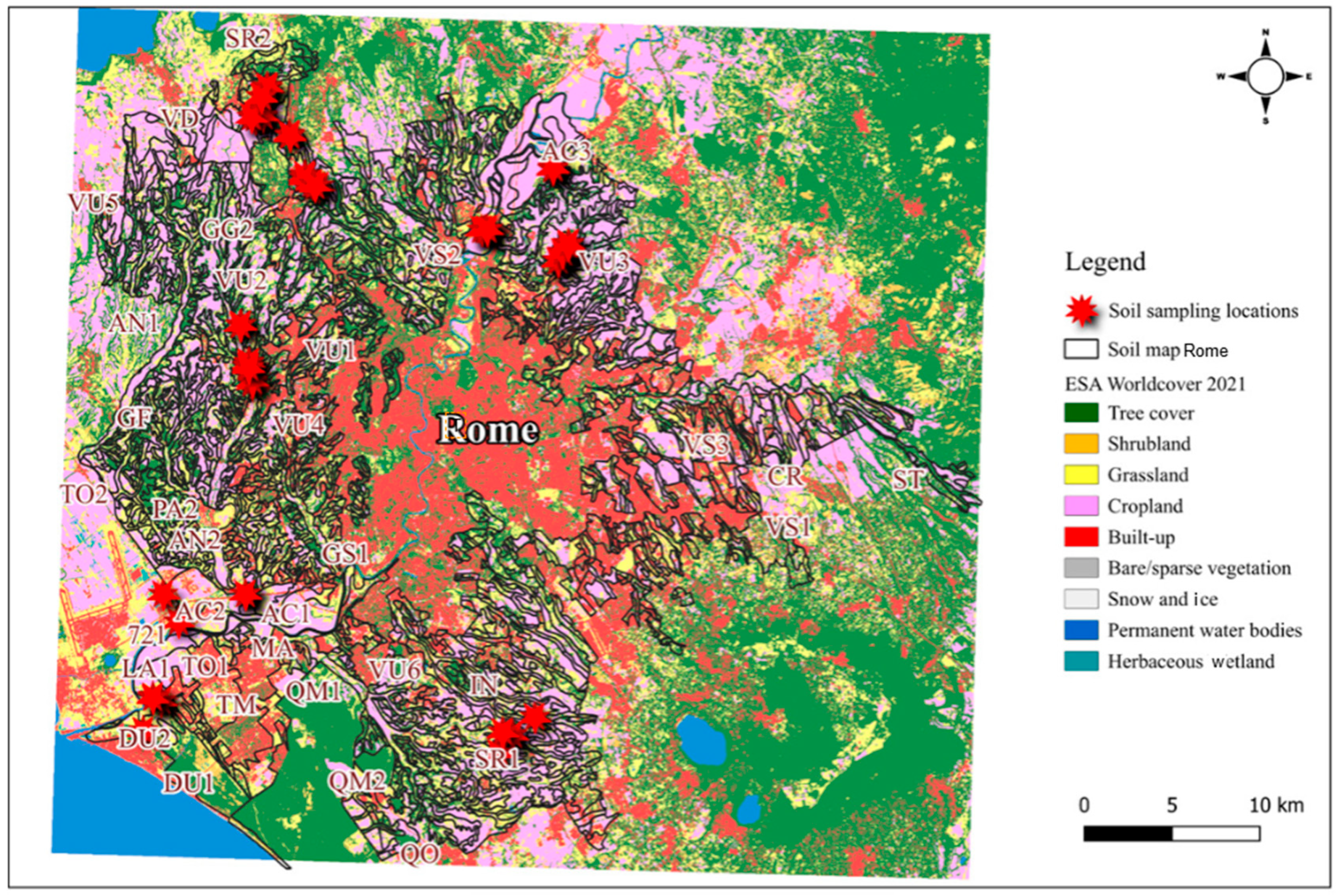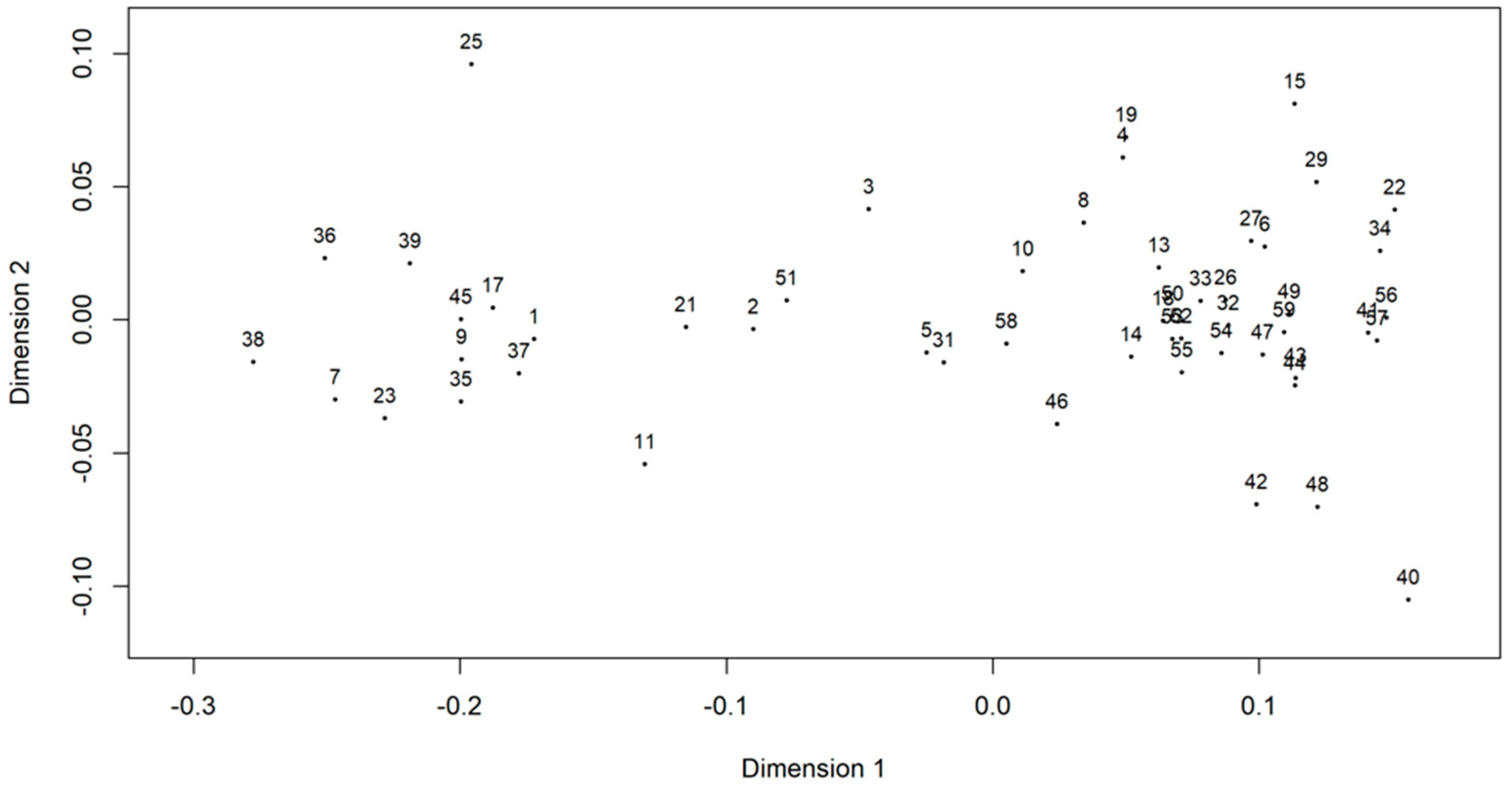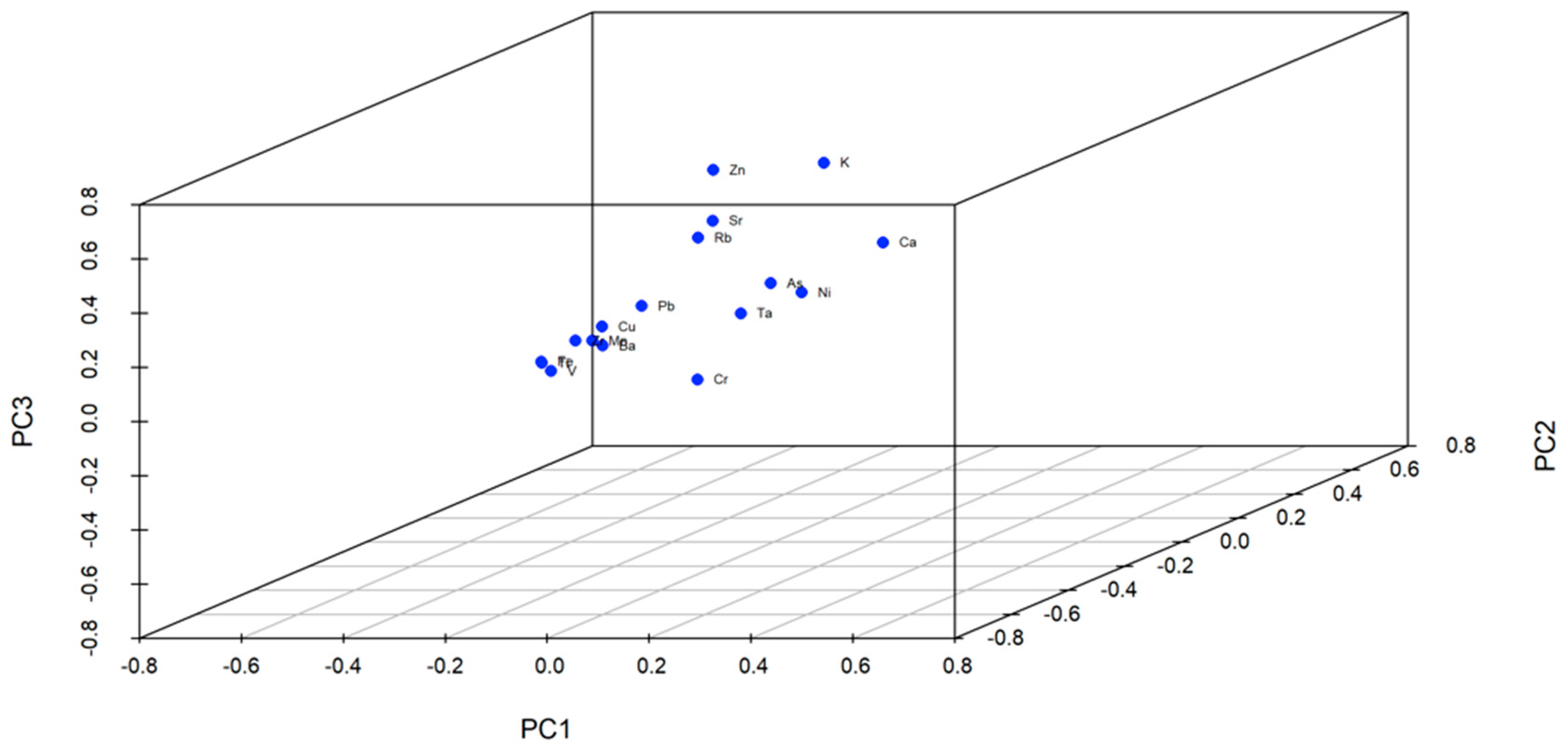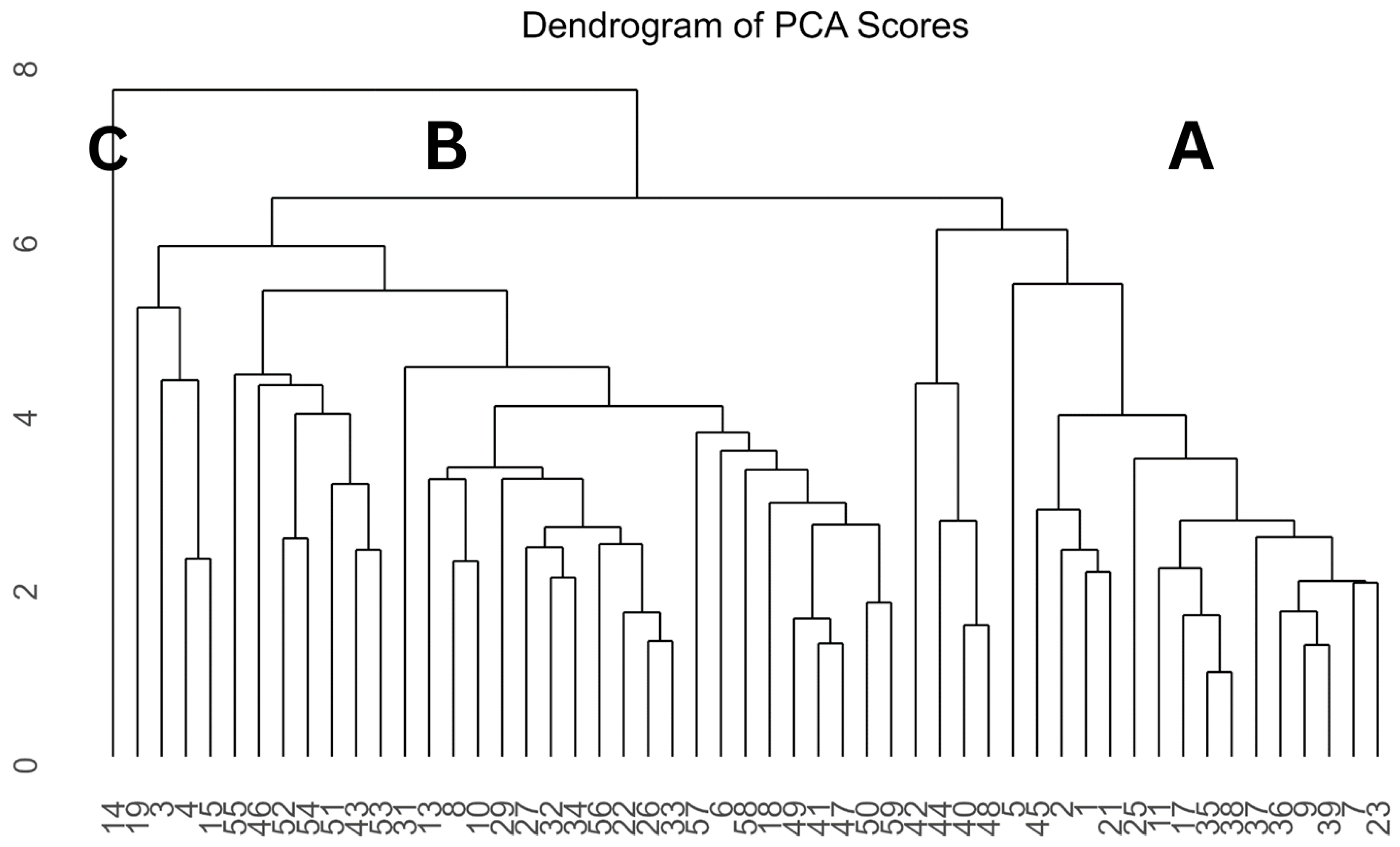Screening Urban Soil Contamination in Rome: Insights from XRF and Multivariate Analysis
Abstract
1. Introduction
2. Materials and Methods
2.1. Study Area, Soil Sampling, and Sample Preparation
2.2. XRF Analysis
2.3. Descriptive Statistics and Multivariate Analysis
2.4. Spatial Clustering
3. Results and Discussion
3.1. Descriptive Statistics for XRF Contents in Soil Samples
3.2. Nonlinear Multidimensional Scaling (NLM)
3.3. Principal Component Analysis (PCA)
3.4. Hierarchical Cluster Analysis Based on PCA Scores
3.5. Spatial Clustering of Soil Samples
- -
- Cluster 0 (pink): Mostly located in the northern and southwestern parts of the study area. The close grouping of points suggests that these locations share similar soil characteristics;
- -
- Cluster I (light green): These are primarily found as two clusters, one in the southeastern part and another in the northeastern part of the study area. These locations share distinct soil characteristics;
- -
- Cluster II (red): Distributed across the northern region, with a moderate spread suggesting some variability within the group;
- -
- Cluster III (cyan): Found in the northwest and western parts of the study area. The close grouping of points indicates high similarity in soil properties;
- -
- Cluster IV (soft blue): Located in the southwestern region of the study area, forming a small, isolated cluster. This indicates a unique set of soil properties distinct from other clusters;
- -
- Cluster V (orange): Found in the western and south-western coastal regions. The clustering pattern suggests these locations have highly similar soil compositions.
- -
- Cluster 0 is characterized by high concentrations of calcium (Ca) with an average of 75,713 mg/kg, followed by iron (Fe) at 35,599 mg/kg and potassium (K) at 17,315 mg/kg. Potassium shows relatively moderate variability, while calcium and iron exhibit more significant variability. Other elements, such as titanium (Ti) and manganese (Mn), have moderate concentrations. Notably, this cluster shows low or non-detectable levels of arsenic (As), molybdenum (Mo), tin (Sn), and barium (Ba), indicating a distinct geochemical profile;
- -
- Cluster I exhibits lower average concentrations of calcium (Ca) (20,336 mg/kg) and potassium (K) (12,626 mg/kg) compared to Cluster 0, but it exhibits higher variability, as indicated by the more significant standard deviations. However, it shows higher iron (Fe) and manganese (Mn) concentrations, averaging 51,171 mg/kg and 1347 mg/kg, respectively. This cluster also indicates a high rubidium (Rb) and strontium (Sr) concentration, suggesting a different geochemical environment. The variability in concentrations, particularly for Ca and K, is higher in this cluster, indicating more heterogeneous soil compositions. In Cluster I, the standard deviation for Ca is 9954 mg/kg, which is relatively high compared to the standard deviation in Cluster 0 (5545 mg/kg). This indicates that although Cluster I has a lower average concentration of Ca, the Ca levels across samples within this cluster are more spread out (more significant variability). Similarly, the standard deviation for K in Cluster I is 3323 mg/kg, which is higher than that in Cluster 0 (959 mg/kg), again suggesting more significant variability in K concentrations within Cluster I. The higher standard deviations for Ca (9954 mg/kg) and K (3323 mg/kg) indicate more heterogeneous soil compositions within this cluster;
- -
- Cluster II stands out due to the exceptionally high concentrations of titanium (Ti) at 16,191 mg/kg and chromium (Cr) at 13,900 mg/kg. Additionally, this cluster has the highest average manganese (Mn) content (2049 mg/kg) and elevated levels of nickel (Ni) and vanadium (V). This cluster is distinguished by its exceptionally high concentration of calcium (Ca) at 94,883 mg/kg, the highest among all of the clusters. This cluster also has a relatively high concentration of iron (Fe) at 60,819 mg/kg, making these two elements particularly significant in defining the geochemical profile of Cluster 2. The variability in these elements is moderate, suggesting some consistency within this cluster’s geochemical characteristics;
- -
- Cluster III is marked by the highest average concentrations of rubidium (Rb) at 434 mg/kg and strontium (Sr) at 1082 mg/kg, along with notable levels of potassium (K) at 20,682 mg/kg. However, this cluster has the lowest levels of chromium (Cr) and a deficient presence of heavy metals, which could indicate a less contaminated or different soil formation process;
- -
- Cluster IV is unique for its high lead (Pb) concentration, averaging 933 mg/kg, and it shows elevated copper (Cu) levels (304 mg/kg) as well. The presence of other elements is moderate, with no detectable levels of chromium (Cr). The high concentration of Pb could indicate specific contamination sources or unique soil conditions in this cluster;
- -
- Cluster V shows moderate concentrations of most elements, with Ca at 54,047 mg/kg and Ti at 3609 mg/kg. The variability within this cluster is notable, especially in relation to lead (Pb) and calcium (Ca), suggesting a mixed composition of soils. Although it does not have extreme concentrations of any particular element, the standard deviations indicate considerable heterogeneity.
4. Conclusions
Supplementary Materials
Author Contributions
Funding
Data Availability Statement
Acknowledgments
Conflicts of Interest
References
- Armiento, G.; Bellatreccia, F.; Cremisini, C.; Della Ventura, G.; Nardi, E.; Pacifico, R. Beryllium Natural Background Concentration and Mobility: A Reappraisal Examining the Case of High Be-Bearing Pyroclastic Rocks. Environ. Monit. Assess. 2013, 185, 559–572. [Google Scholar] [CrossRef] [PubMed]
- Cinti, D.; Angelone, M.; Masi, U.; Cremisini, C. Platinum Levels in Natural and Urban Soils from Rome and Latium (Italy): Significance for Pollution by Automobile Catalytic Converter. Sci. Total Environ. 2002, 293, 47–57. [Google Scholar] [CrossRef] [PubMed]
- Re, I.; Bosco, D.; Henzen, E. Soil Contamination from Hydrocarbons in Italy. A Mapping of Progress in the Remediation of Sites of National and Regional Interest; Consorzio Italbiotec: Milano, Italy, 2019. [Google Scholar] [CrossRef]
- Egidi, G.; Zambon, I.; Tombolin, I.; Salvati, L.; Cividino, S.; Seifollahi-Aghmiuni, S.; Kalantari, Z. Unraveling Latent Aspects of Urban Expansion: Desertification Risk Reveals More. Int. J. Environ. Res. Public Health 2020, 17, 4001. [Google Scholar] [CrossRef] [PubMed]
- Perrone, F.; Gallucci, F.; Mosconi, E.M.; Salvati, L. Soil Quality and Urban Sprawl: Insights from Long-Term Patterns in the Rome Metropolitan Region. In Advances in Chemical Pollution, Environmental Management and Protection; Elsevier: Amsterdam, The Netherlands, 2022; Volume 8, pp. 91–111. ISBN 978-0-12-820180-0. [Google Scholar]
- Calace, N.; Caliandro, L.; Petronio, B.M.; Pietrantonio, M.; Pietroletti, M.; Trancalini, V. Distribution of Pb, Cu, Ni, and Zn in Urban Soils in Rome City (Italy): Effect of Vehicles. Environ. Chem. 2012, 9, 69. [Google Scholar] [CrossRef]
- Ajmone Marsan, F.; Zanini, E. Soils in Urban Areas. In The Soils of Italy; Costantini, E.A.C., Dazzi, C., Eds.; World Soils Book Series; Springer: Dordrecht, The Netherlands, 2013; pp. 295–302. ISBN 978-94-007-5641-0. [Google Scholar]
- Imperato, M.; Adamo, P.; Naimo, D.; Arienzo, M.; Stanzione, D.; Violante, P. Spatial Distribution of Heavy Metals in Urban Soils of Naples City (Italy). Environ. Pollut. 2003, 124, 247–256. [Google Scholar] [CrossRef]
- Caporale, A.G.; Adamo, P.; Capozzi, F.; Langella, G.; Terribile, F.; Vingiani, S. Monitoring Metal Pollution in Soils Using Portable-XRF and Conventional Laboratory-Based Techniques: Evaluation of the Performance and Limitations According to Metal Properties and Sources. Sci. Total Environ. 2018, 643, 516–526. [Google Scholar] [CrossRef]
- Declercq, Y.; Delbecque, N.; De Grave, J.; De Smedt, P.; Finke, P.; Mouazen, A.M.; Nawar, S.; Vandenberghe, D.; Van Meirvenne, M.; Verdoodt, A. A Comprehensive Study of Three Different Portable XRF Scanners to Assess the Soil Geochemistry of An Extensive Sample Dataset. Remote Sens. 2019, 11, 2490. [Google Scholar] [CrossRef]
- Hout, M.C.; Papesh, M.H.; Goldinger, S.D. Multidimensional Scaling. WIRES Cogn. Sci. 2013, 4, 93–103. [Google Scholar] [CrossRef]
- Young, F.W.; Takane, Y.; Lewyckyj, R. ALSCAL: A Nonmetric Multidimensional Scaling Program with Several Individual-Differences Options. Behav. Res. Methods Instrum. 1978, 10, 451–453. [Google Scholar] [CrossRef]
- Carlotto, M.J. Nonlinear Mapping Algorithm and Applications for Multidimensional Data Analysis. J. Vis. Commun. Image Represent. 1994, 5, 127–138. [Google Scholar] [CrossRef]
- Duan, C.; Wang, B.; Li, J. Prediction Model of Soil Heavy Metal Content Based on Particle Swarm Algorithm Optimized Neural Network. Comput. Intell. Neurosci. 2022, 9693175. [Google Scholar] [CrossRef] [PubMed]
- Hanesch, M.; Scholger, R.; Dekkers, M.J. The Application of Fuzzy C-Means Cluster Analysis and Nonlinear Mapping to a Soil Data Set for the Detection of Polluted Sites. Phys. Chem. Earth Part A Solid Earth Geod. 2001, 26, 885–891. [Google Scholar] [CrossRef]
- Borůvka, L.; Vacek, O.; Jehlička, J. Principal Component Analysis as a Tool to Indicate the Origin of Potentially Toxic Elements in Soils. Geoderma 2005, 128, 289–300. [Google Scholar] [CrossRef]
- Lu, W.-Z.; He, H.-D.; Dong, L. Performance Assessment of Air Quality Monitoring Networks Using Principal Component Analysis and Cluster Analysis. Build. Environ. 2011, 46, 577–583. [Google Scholar] [CrossRef]
- Aidoo, E.N.; Appiah, S.K.; Awashie, G.E.; Boateng, A.; Darko, G. Geographically Weighted Principal Component Analysis for Characterising the Spatial Heterogeneity and Connectivity of Soil Heavy Metals in Kumasi, Ghana. Heliyon 2021, 7, e08039. [Google Scholar] [CrossRef] [PubMed]
- El Behairy, R.; El Baroudy, A.; Ibrahim, M.; Mohamed, E.; Rebouh, N.; Shokr, M. Combination of GIS and Multivariate Analysis to Assess the Soil Heavy Metal Contamination in Some Arid Zones. Agronomy 2022, 12, 2871. [Google Scholar] [CrossRef]
- Facchinelli, A.; Sacchi, E.; Mallen, L. Multivariate Statistical and GIS-Based Approach to Identify Heavy Metal Sources in Soils. Environ. Pollut. 2001, 114, 313–324. [Google Scholar] [CrossRef]
- Wang, H.; Song, C.; Wang, J.; Gao, P. A Raster-Based Spatial Clustering Method with Robustness to Spatial Outliers. Sci. Rep. 2024, 14, 4103. [Google Scholar] [CrossRef]
- Chandramohan, M.S.; Da Silva, I.M.; Da Silva, J.E. Concentrations of Potentially Toxic Elements in Topsoils of Urban Agricultural Areas of Rome. Environments 2024, 11, 34. [Google Scholar] [CrossRef]
- Province/Città Metropolitane per Popolazione. Available online: https://www.tuttitalia.it/province/popolazione/ (accessed on 30 June 2024).
- QGIS (Quantum Geographic Information System)—Free and Open Source Software (FOSS). Download QGIS. Available online: https://www.qgis.org/en/site/forusers/download.html (accessed on 30 June 2024).
- Rome 2023 Past Weather (Italy)—Weather Spark. Available online: https://weatherspark.com/h/y/71779/2023/Historical-Weather-during-2023-in-Rome-Italy#Sections-Pressure (accessed on 30 June 2024).
- Urban Atlas. Available online: https://land.copernicus.eu/en/products/urban-atlas (accessed on 1 July 2024).
- Regional Technical Map (CTR), Roma—Scale 1:10.000—V. 1990/1991—TIF Document Format; Regional Technical Map (CTR). Welcome!—Geoportale.Regione.Lazio.It. Available online: https://geoportale.regione.lazio.it/ (accessed on 1 July 2024).
- Soil Map of the Municipality of Rome in Scale 1:50.000—The Soils of Rome, 2003 ed., Huijzendveld, A.A.-H. (Tonnie Arnoldus-Huyzendveld A., 2003 (TESTO)—I Suoli Di Roma: Due Passi Sulle Terre Della Città; Note Illustrative Della Carta Dei Suoli Del Comune Di Roma in Scala 1:50.000. Available online: https://www.academia.edu/6174568/Arnoldus_Huyzendveld_A_2003_TESTO_I_suoli_di_Roma_due_passi_sulle_terredella_citt%C3%A0_Note_Illustrative_della_Carta_dei_Suoli_del_Comune_di_Roma_in_scala_1_50_000?hb-sb-sw=20197271 (accessed on 21 August 2024).
- Binstock, D.A.; Gutknecht, W.F.; McWilliams, A.C. Lead in Soil by Field-Portable x-Ray Fluorescence Spectrometry—An Examination of Paired In Situ and Laboratory ICP-AES Results. Remediat. J. 2008, 18, 55–61. [Google Scholar] [CrossRef]
- Du, G.; Lei, M.; Zhou, G.; Chen, T.; Qiu, R. Evaluation of Field Portable X-Ray Fluorescence Performance for the Analysis of Ni in Soil. Guang Pu Xue Yu Guang Pu Fen Xi 2015, 35, 809–813. [Google Scholar]
- Kalnicky, D.J.; Singhvi, R. Field Portable XRF Analysis of Environmental Samples. J. Hazard. Mater. 2001, 83, 93–122. [Google Scholar] [CrossRef] [PubMed]
- Rouillon, M.; Taylor, M.P.; Dong, C. Reducing Risk and Increasing Confidence of Decision Making at a Lower Cost: In-Situ pXRF Assessment of Metal-Contaminated Sites. Environ. Pollut. 2017, 229, 780–789. [Google Scholar] [CrossRef] [PubMed]
- Weindorf, D.C.; Zhu, Y.; Chakraborty, S.; Bakr, N.; Huang, B. Use of Portable X-Ray Fluorescence Spectrometry for Environmental Quality Assessment of Peri-Urban Agriculture. Environ. Monit. Assess. 2012, 184, 217–227. [Google Scholar] [CrossRef] [PubMed]
- Senra, B.P.; Ribeiro, H.; Guedes, A. Technical note: Application of Handheld X-ray fluorescence spectrometers in forensic analysis of cigarette ash. Forensic Sci. Int. 2024, 361, 112083. [Google Scholar] [CrossRef]
- Posit Team. RStudio: Integrated Development Environment for R. Posit Software; PBC: Boston, MA, USA, 2023; Posit; Available online: https://www.posit.co/ (accessed on 1 July 2024).
- Chakravarti, I.M.; Laha, R.G.; Roy, J. Handbook of Methods of Applied Statistics; John Wiley and Sons: Hoboken, NJ, USA, 1967; Volume I, pp. 392–394. [Google Scholar]
- Einax, J.W.; Zwanziger, H.W.; Geib, S. Chemometrics in Environmental Analysis; VCH Wiley: Weinheim, Germany, 1997. [Google Scholar]
- Bretzel, F.; Calderisi, M. Metal Contamination in Urban Soils of Coastal Tuscany (Italy). Environ. Monit. Assess. 2006, 118, 319–335. [Google Scholar] [CrossRef]
- Radhi, A.B.; Shartooh, S.M.; Al-Heety, E.A. Heavy Metal Pollution and Sources in Dust from Primary Schools and Kindergartens in Ramadi City, Iraq. Iraqi J. Sci. 2021, 62, 1816–1828. [Google Scholar] [CrossRef]
- Unsal, M.H.; Ignatavičius, G.; Valskys, V. Unveiling Heavy Metal Links: Correlating Dust and Topsoil Contamination in Vilnius Schools. Land 2024, 13, 79. [Google Scholar] [CrossRef]
- Forkman, J.; Josse, J.; Piepho, H.-P. Hypothesis Tests for Principal Component Analysis When Variables Are Standardized. J. Agric. Biol. Environ. Stat. 2019, 24, 289–308. [Google Scholar] [CrossRef]
- Johnson, R.A.; Wichern, D.W. Applied Multivariate Statistical Analysis; Prentice Hall: Upper Saddle River, NJ, USA, 2002. [Google Scholar]
- Abdi, H.; Williams, L.J. Principal Component Analysis. WIREs Comp. Stat. 2010, 2, 433–459. [Google Scholar] [CrossRef]
- Python Software Foundation. Python Language Reference, Version 3.10. Available online: http://www.python.org (accessed on 30 June 2024).
- Wieczorek, K.; Turek, A.; Szczesio, M.; Wolf, W.M. Comprehensive Evaluation of Metal Pollution in Urban Soils of a Post-Industrial City—A Case of Łódź, Poland. Molecules 2020, 25, 4350. [Google Scholar] [CrossRef]
- Shand, C.A.; Wendler, R. Portable X-ray Fluorescence Analysis of Mineral and Organic Soils and the Influence of Organic Matter. J. Geochem. Explor. 2014, 143, 31–42. [Google Scholar] [CrossRef]
- Sammon, J.W., Jr. A Nonlinear Mapping for Data Structure Analysis. IEEE Trans. Comput. 1969, 100, 401–409. [Google Scholar] [CrossRef]
- Balabanova, B.; Stafilov, T.; Baceva, K. Application of Principal Component Analysis in the Assessment of Essential and Toxic Metals in Vegetable and Soil from Polluted and Referent Areas. Bulg. J. Agric. Sci. 2015, 21, 552–560. [Google Scholar]
- Han, L.; Li, Y. Distributions, Source, and Pollution Status of Heavy Metals of Urban Soil in Xining, China. IOP Conf. Ser. Earth Environ. Sci. 2020, 555, 012084. [Google Scholar] [CrossRef]
- Ahmed, F.; Fakhruddin, A.N.M.; Imam, M.D.T.; Khan, N.; Khan, T.A.; Rahman, M.M.; Abdullah, A.T.M. Spatial Distribution and Source Identification of Heavy Metal Pollution in Roadside Surface Soil: A Study of Dhaka Aricha Highway, Bangladesh. Ecol. Process. 2016, 5, 2. [Google Scholar] [CrossRef]
- Chang, S.-H.; Wang, K.-S.; Chang, H.-F.; Ni, W.-W.; Wu, B.-J.; Wong, R.-H.; Lee, H.-S. Comparison of Source Identification of Metals in Road-Dust and Soil. Soil Sediment Contam. 2009, 18, 669–683. [Google Scholar] [CrossRef]
- Mali, M.; Di Leo, A.; Giandomenico, S.; Spada, L.; Cardellicchio, N.; Calò, M.; Fedele, A.; Ferraro, L.; Milia, A.; Renzi, M.; et al. Multivariate Tools to Investigate the Spatial Contaminant Distribution in a Highly Anthropized Area (Gulf of Naples, Italy). Environ. Sci. Pollut. Res. 2022, 29, 62281–62298. [Google Scholar] [CrossRef]
- Salvati, L. Monitoring High-Quality Soil Consumption Driven by Urban Pressure in a Growing City (Rome, Italy). Cities 2013, 31, 349–356. [Google Scholar] [CrossRef]
- Krami, L.K.; Amiri, F.; Sefiyanian, A.; Mohamed Shariff, A.R.B.; Tabatabaie, T.; Pradhan, B. Spatial Patterns of Heavy Metals in Soil Under Different Geological Structures and Land Uses for Assessing Metal Enrichments. Environ. Monit. Assess. 2013, 185, 9871–9888. [Google Scholar] [CrossRef]
- Kahangwa, C.A. Application of Principal Component Analysis, Cluster Analysis, Pollution Index and Geoaccumulation Index in Pollution Assessment with Heavy Metals from Gold Mining Operations, Tanzania. J. Geosci. Environ. Prot. 2022, 10, 303–317. [Google Scholar] [CrossRef]
- Wang, D.; Wang, X.; Liu, L.; Wang, D.; Zeng, Z. Urban Signatures in the Spatial Clustering of Precipitation Extremes over Mainland China. J. Hydrometeorol. 2021, 22, 639–656. [Google Scholar] [CrossRef]
- Yu, B.; Shu, S.; Liu, H.; Song, W.; Wu, J.; Wang, L.; Chen, Z. Object-Based Spatial Cluster Analysis of Urban Landscape Pattern Using Nighttime Light Satellite Images: A Case Study of China. Int. J. Geogr. Inf. Sci. 2014, 28, 2328–2355. [Google Scholar] [CrossRef]






| K | Ca | Ti | V | Cr | Mn | Fe | Ni | Cu | Zn | As | Rb | Sr | Zr | Mo | Sn | Ba | Ta | Pb | |
|---|---|---|---|---|---|---|---|---|---|---|---|---|---|---|---|---|---|---|---|
| Mean | 15,938 | 39,995 | 5143 | 274 | 997 | 1175 | 42,435 | 229 | 43 | 71 | 8 | 275 | 640 | 282 | 7 | 3 | 200 | 15 | 89 |
| Minimum | 3191 | 6058 | 2352 | <LD | <LD | 441 | 17,612 | <LD | <LD | 23 | <LD | 50 | 221 | 65 | <LD | <LD | <LD | <LD | <LD |
| Q1 | 14,224 | 15,188 | 3804 | 110 | <LD | 914 | 36,205 | 21 | 20 | 62 | <LD | 158 | 336 | 176 | <LD | <LD | 166 | <LD | 44 |
| Median | 16,417 | 25,285 | 4327 | 172 | 68 | 1120 | 40,881 | 28 | 30 | 69 | <LD | 247 | 510 | 325 | <LD | <LD | 224 | 19 | 71 |
| Q3 | 18,056 | 71,126 | 5114 | 214 | 102 | 1376 | 50,018 | 43 | 46 | 80 | 20 | 372 | 799 | 366 | <LD | <LD | 266 | 25 | 83 |
| Maximum | 31,316 | 123,059 | 17,816 | 1957 | 15,122 | 2163 | 62,414 | 3512 | 304 | 118 | 35 | 781 | 1829 | 437 | 110 | 47 | 415 | 75 | 933 |
| Skewness | 0.01 | 0.72 | 3.13 | 3.34 | 3.50 | 0.68 | 0.23 | 3.58 | 3.33 | 0.32 | 1.09 | 0.97 | 1.29 | −0.36 | 3.45 | 3.48 | −0.75 | 1.06 | 5.64 |
| Kurtosis | 4 | 2 | 12 | 13 | 13 | 3 | 3 | 14 | 16 | 4 | 2 | 4 | 4 | 2 | 13 | 13 | 3 | 4 | 38 |
| K-Sp | 0.17 | 0.01 | <0.01 | <0.01 | <0.01 | 0.70 | 0.37 | <0.01 | <0.01 | 0.36 | <0.01 | 0.51 | 0.07 | 0.08 | <0.01 | <0.01 | 0.14 | <0.01 | <0.01 |
| CV [%] | 35 | 79 | 61 | 154 | 354 | 32 | 24 | 329 | 111 | 25 | 165 | 53 | 63 | 38 | 374 | 375 | 53 | 115 | 140 |
| Cluster * | K | Ca | Ti | V | Cr | Mn | Fe | Ni | Cu | Zn | As | Rb | Sr | Zr | Mo | Sn | Ba | Ta | Pb |
|---|---|---|---|---|---|---|---|---|---|---|---|---|---|---|---|---|---|---|---|
| 0 | 17,315 (959) | 75,713 (5545) | 3737 (297) | 88 (15) | 100 (12) | 856 (155) | 35,599 (4911) | 49 (7) | 24 (6) | 82 (16) | <DL | 143 (19) | 288 (43) | 149 (26) | <DL | <DL | <DL | 21 (15) | 33 (2) |
| I | 12,626 (3323) | 20,336 (9954) | 5203 (568) | 239 (71) | 87 (33) | 1347 (200) | 51,171 (5970) | 30 (6) | 44 (20) | 68 (8) | 2 (9) | 277 (71) | 549 (191) | 368 (42) | <DL | <DL | 248 (65) | 15 (13) | 94 (32) |
| II | 4516 (1599) | 94,883 (4199) | 16,191 (1662) | 1787 (217) | 13,900 (1615) | 2049 (110) | 60,819 (1688) | 2958 (521) | 144 (14) | 63 (6) | <DL | 109 (35) | 293 (89) | 110 (43) | 106 (4) | 42 (4) | 304 (20) | 55 (15) | 28 (32) |
| III | 20,682 (4902) | 17,998 (10,111) | 4422 (685) | 182 (35) | 26 (32) | 1210 (247) | 40,307 (6662) | 20 (6) | 28 (17) | 74 (19) | 24 (13) | 434 (115) | 1082 (389) | 359 (41) | <DL | 0 (0) | 252 (51) | 13 (13) | 93 (71) |
| IV | 14,824 | 78,929 | 3442 | 111 | <DL | 894 | 38,343 | 34 | 304 | 103 | <DL | 161 | 609 | 216 | <DL | <DL | 169 | <DL | 933 |
| V | 15,551 (2386) | 54,047 (33,853) | 3609 (560) | 96 (41) | 51 (48) | 851 (198) | 33,654 (7042) | 33 (14) | 26 (19) | 66 (25) | 1 (2) | 171 (56) | 407 (130) | 202 (52) | <DL | <DL | 160 (83) | 2 (6) | 64 (50) |
Disclaimer/Publisher’s Note: The statements, opinions and data contained in all publications are solely those of the individual author(s) and contributor(s) and not of MDPI and/or the editor(s). MDPI and/or the editor(s) disclaim responsibility for any injury to people or property resulting from any ideas, methods, instructions or products referred to in the content. |
© 2025 by the authors. Licensee MDPI, Basel, Switzerland. This article is an open access article distributed under the terms and conditions of the Creative Commons Attribution (CC BY) license (https://creativecommons.org/licenses/by/4.0/).
Share and Cite
Chandramohan, M.S.; Martinho da Silva, I.; Ribeiro, R.P.; Jorge, A.; Esteves da Silva, J. Screening Urban Soil Contamination in Rome: Insights from XRF and Multivariate Analysis. Environments 2025, 12, 126. https://doi.org/10.3390/environments12040126
Chandramohan MS, Martinho da Silva I, Ribeiro RP, Jorge A, Esteves da Silva J. Screening Urban Soil Contamination in Rome: Insights from XRF and Multivariate Analysis. Environments. 2025; 12(4):126. https://doi.org/10.3390/environments12040126
Chicago/Turabian StyleChandramohan, Monica Shree, Isabel Martinho da Silva, Rita P. Ribeiro, Alípio Jorge, and Joaquim Esteves da Silva. 2025. "Screening Urban Soil Contamination in Rome: Insights from XRF and Multivariate Analysis" Environments 12, no. 4: 126. https://doi.org/10.3390/environments12040126
APA StyleChandramohan, M. S., Martinho da Silva, I., Ribeiro, R. P., Jorge, A., & Esteves da Silva, J. (2025). Screening Urban Soil Contamination in Rome: Insights from XRF and Multivariate Analysis. Environments, 12(4), 126. https://doi.org/10.3390/environments12040126








